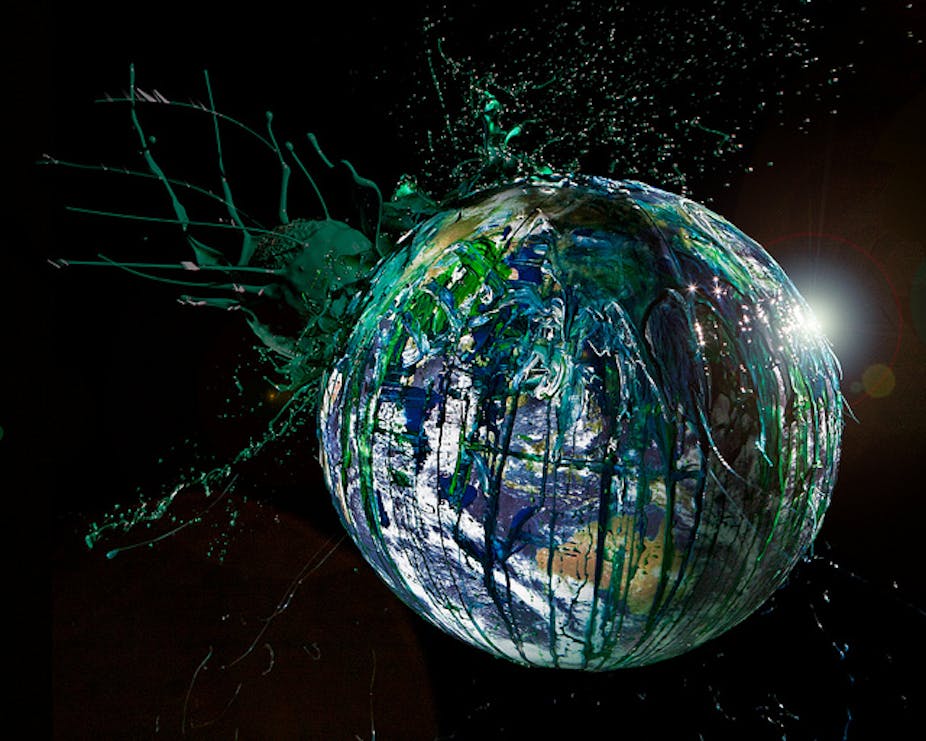We know a lot about how humans evolved. But when it comes to our planet, we’re on shakier ground.
Inert (nonreactive) gases, such as helium, neon and argon, trapped inside the mantle (Earth’s thickest layer) provide important clues that help scientists reconstruct the planet’s evolution.
Our research, published yesterday in Nature Geoscience, shows inert gases in the atmosphere are injected into the Earth’s mantle through a process called subduction, during which one of Earth’s plates submerges below another.
This implies the gases in Earth’s interior have not faithfully preserved the original fingerprint of solar system formation.
It was previously thought the gases in the mantle were largely delivered by meteorites that crashed into Earth after the moon had formed.
Our discovery throws these theories about Earth’s evolution into question.
Beneath the face of Earth
Earth is unique within our solar system. It has a solid surface, air we can breathe and liquid water we can drink.

These coincidences, without which life on Earth would not exist, are a result of our distance from the sun and the unique tectonic processes that have governed the planet’s 4.5 billion year evolution.
Earth’s crust represents a thin skin of tectonic plates up to 40km thick, which float on top of a 2,900 kilometre-thick mantle.
Volcanic spreading centres span thousands of kilometres under Earth’s oceans. Molten rock forms oceanic plates that move away from these volcanic spreading centres like conveyor belts.
The oceanic plates then sink back into the mantle, a phenomenon that occurs beneath volcanic regions such as the South American Andes and Japan.
Inert gases
Inert gases released from the mantle at volcanic spreading centres have multiple isotopes (forms of a single element with different mass) that help fingerprint Earth’s evolution.

Some of the isotopes do represent the building blocks of our solar system, while others are produced by radioactive decay of elements in the mantle.
Traditionally, these isotopes have been used to understand the extent to which the mantle has been melted and degassed to produce the overlying crust, oceans and atmosphere.
What we did
It has been increasingly recognised that volatiles (a class of element that includes water, chlorine and carbon) may be recycled from the atmosphere and ocean, back into the mantle with subducting tectonic plates.
Our current study was undertaken by collecting serpentinites and related rocks from mountains in Italy and Spain.

These rocks originally formed on the seafloor and were partially driven into Earth’s mantle before the European and African plates collided, forming the Alps and lifting the rocks to the surface.
Serpentinite rocks are special because the main mineral, serpentine, traps large amounts of seawater in its crystal structure, and can be transported to depths of 200-250km in Earth’s mantle.
By analysing the gases and chlorine trapped in these rocks, it was possible to show how the rock acts as an efficient trap for inert gases, despite the inability of these gases to form chemical bonds.
Even more importantly, the work shows the gases are not completely lost from this type of rock when it is pushed to depths of more than 200km under Earth’s surface.
A volatile life
Our study implies the behaviour of inert gases is more similar to that of seawater than was previously realised.
Many scientists assumed the composition of inert gases in volcanic spreading centres resulted from mixing mantle gas with gases dissolved in seawater close to the spreading centre.
But the variable composition of these gases can now be partly explained by the recycling of elements through the mantle from the point where plates get sucked beneath one another.
Furthermore, it may now be possible to use the distinctive fingerprint of inert gases sampled from different parts of the mantle to track the fate of other volatiles.
How Earth began
The serpentinite rocks have higher than expected concentrations of atmospheric neon. The neon isotope composition of Earth’s mantle is very similar to that of meteorites.
This led scientists to suggest Earth’s original volatiles were lost when a Mars-sized object collided with the Earth, creating the moon.
Gases were subsequently delivered by a later meteorite shower and circulated throughout the young planet.

But if our theory is taken into account, it now appears more likely that some of the gases in Earth’s mantle originated during an earlier stage of solar system formation from the solar nebulae.
That would mean Earth has preserved some of it original gases, but the isotopic fingerprints of these gases have been altered.
The mantle has been more efficiently processed and mixed with gases from a distinct atmospheric reservoir than previously realised.
So, what does this all mean?
The Earth has had a turbulent past, colliding with other planets, being pummelled by meteors, having its plates thrust together and pulled apart.
But there’s a process going on to this day that’s permanently changing the composition of our planet, just below the surface we walk on.
Our theory is, you could say, a step change in our understanding of Earth.

